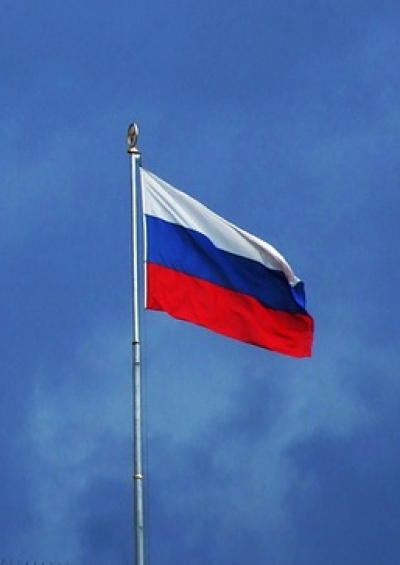Siberia — Communist Megalomania?
What geographic, political and economic factors led to the failure of the Communist dream during the 20th century?
February 2, 2004

America and Russia headed for their respective coasts in roughly the same timeframe. They started from different points on the globe and moved in opposite directions — and yet they both ended up pushing toward the Pacific.
In that process, one country won the West. The other conquered the East.
In the United States in the 1880s, the land rush and trans-continental railroads strung homesteads, farms and towns out across the vast grasslands of the Plains that cover one sixth of the U.S. landmass.
In Russia in the 1890s, the Trans-Siberian railroad allowed settlers to move out across three-quarters of Russian territory into the wilderness areas of Siberia.
In less than a century, both the U.S. plains and Siberia were transformed from frontier lands and distant peripheries into the mythical heartlands of their states.
But the push to the Pacific had very different outcomes for the two continental powers. By the end of the 20th century, while the American dream seemed to have materialized in the West, the Communist dream had foundered in the East.
Communism dragged Russia kicking and screaming into the modern world. It brought electricity, full literacy, some of the world's largest industrial enterprises and ultimately a nuclear arsenal and space program comparable to America's.
Still, the socialist utopia remained a distant goal — and prosperity was elusive. The zeal of Communist planners ran afoul of the harsh realities and peculiarities of Russia's geography and climate.
Not only is Russia the world's biggest country — about twice as big as the United States and covering 17 million square kilometers and 11 time zones — it is also the coldest.
Russia has twice as much land above the Arctic Circle as Canada, ten times as much as Alaska — and about 15 times as much as Norway, Sweden and Finland combined.
In Russia, because of the size of the landmass and its distance from the moderating effect of temperate oceans, it also gets colder the further east you travel, not the further north as in America.
There are the same extremes of temperature in the middle of the country, in Siberia, that the U.S. Plains states experience, but there is little beneficial ocean effect once you reach the Pacific.
It is a full 13 degrees colder in January on Russia's Pacific coast than it is in Moscow, while in the United States, it is more than 9 degrees warmer on the Pacific coast than in, say, New York.
The extremes in the interior of Russia are also truly extreme. Temperatures routinely fall to below -50C (-58F) in January for prolonged periods of time.
And the coldest temperature ever measured outside Antarctica — at –68C (-90F) — was recorded in the Yakutia region of Siberia. Regardless of these statistics, millions of people were moved into Siberia and into this region of inhospitable cold in the 20th century.
The bulk of them arrived in the Communist period after the Soviet state launched a mass industrialization campaign at the end of the 1920s.
There were only about 10 million people living in Siberia — across the whole area from the Ural Mountains to the Pacific Ocean — at the time of the Russian Revolution in 1917, in contrast to about 40 million today.
Siberian migration was on a much bigger scale, and of a very different nature to the movement of people into the American Plains. There, hundreds of thousands of people migrated west on a largely voluntary basis.
Yes, Russia did have its version of homesteaders under the Tsars, who were offered land and other inducements to move into Siberia. But in the Soviet period, the state used the GULAG — the prison labor camp system — to force people to go there against their will.
A total of about 18 million people passed through the GULAG system across the Soviet Union during the period of its operations.
Their labor built the basic infrastructure — the roads, railway, factories, dams, canals and power stations — of the modern industrial state, especially in the most remote regions of the USSR.
Those who ended up in Siberia had to stay there even after their prison sentences ended. Prison camps became towns in isolated areas and swelled the populations of the big Siberian cities.
After the GULAG ended, Siberia became a boom region — especially with the opening up of its vast oil and gas fields in the west and enormous coalmines in the east. From the late 1960s to the early 1980s, some of the largest construction and industrial projects in Russian and world history were undertaken in Siberia.
These projects were monumental in their scale and investment — such as the world's largest aluminum plant, huge dams and power plants and the world's longest freight railway line.
The industrialization of Siberia was the apogee of Communism. The Soviet Union conquered the frozen wastes and built things that outside observers thought impossible in the places they were built.
Workers came to Siberia to earn higher wages and special privileges for their families. They also went there for the opportunity to be pioneers in a grand endeavor — the construction of Communism in the permafrost.
The industrialization of Siberia was an exercise in unbridled optimism and demonstrated a great faith in the Soviet system's ability to tame Siberia. It was also the result of a heady concoction of ideological and practical motivations.
At the most basic level, this vast, empty land had to be secured and settled to deter others from seizing it. Industry had to be moved closer to sources of raw material to minimize transportation costs.
And Communist planners wanted a more even spread of population and economic development across the country.
More specifically, after 1929, when the USSR found itself cut-off from a Europe fearful of the contagion of Communism, the plan was to exploit Siberia to make the Soviet Union self-sufficient in strategic natural resources.
In the 1940s, the Soviets turned Siberia into a strategic redoubt — relocating key industries beyond the Ural Mountains and away from vulnerable western lands, overrun by the invading German army.
Eventually, after border clashes with China along the Amur River in the 1960s, the USSR sought to build up Siberia militarily to keep the Chinese at bay.
By the 1980s, approximately 25% of Soviet ground forces, a similar percentage of the air force and about 30% of its naval capacity was based east of the Urals.
Unfortunately, although there was plenty of rationale for transforming Siberia, industrializing the region on such an enormous scale was ultimately an act of folly.
From the perspective of Russia's geography and climate, Communist planners put people, cities and industry in all the wrong places — in the middle of nowhere, in some of the most inhospitable regions of the planet.
A comparable American movement might have entailed the displacement of a huge swathe of the population to North Dakota and Minnesota — or a forced mass migration to Alaska.
Editor’s note: This article was written by Fiona Hill while she was at the Brookings Institution.
Read previous
Tackling South Africa’s Problems
January 31, 2004
